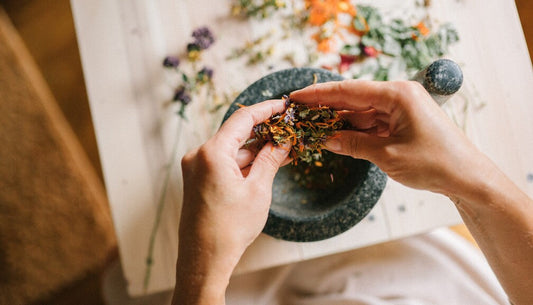Ayurvedic terms are spread throughout this website, app, and our community as a whole. You’ve probably picked up on the meanings of a lot of them, but why struggle when we’ve made this simple guide to understanding common Ayurvedic terms with definitions and examples of how to use them in sentences. Enjoy!
Agni: Translates to "fire" and is commonly referred to in the context of digestion and metabolism
Ama: A toxin or sludge that’s produced when we don’t fully digest or cleanse regularly
Asana: A limb of yoga philosophy that refers to the physical postures or poses
Ayurveda: The science of life supported by the integration and vitality of mind, body, and spirit
Bija: Meaning "seed of sound" most commonly used in reference to mantras
Chakra: Wheel of subtle energy
Dosha: Your Ayurvedic mind-body type or combination of earth elements: Vata, Pitta, and Kapha
Ghee: A type of butter which is clarified by boiling
Kitchari: Means mixture and usually is a combination of two grains that are both easy and nourishing to digest
Ojas: The subtle force in your body that provides health, digestion, strength, and vitality
Mantra: Mind tool or vehicle of the mind
Neti: The process of flushing out the nasal channels using a saline fluid
Panchakarma: The five actions or ways of cleansing and rejuvenating the body traditional in Ayurveda
Prakriti: Your essential nature and unique combination of earth elements or dosha determined at birth
Prana: Our vital life force or breath
Srota: The channels of circulation in the body
Vikruti: Translates to “after creation” and reflects the combination of earth elements in your mind and body right now
These are the most common terms that sprung to our minds. Be on the lookout for more Ayurvedic terminology next month!
Agni: Translates to "fire" and is commonly referred to in the context of digestion and metabolism
- If you have strong agni, you have strong and balanced health in mind and body.
- His agni is so strong that he can eat almost anything!
- Did you know that certain foods can increase agni while others decrease it?
Ama: A toxin or sludge that’s produced when we don’t fully digest or cleanse regularly
- There are ways to decrease ama easily by making small changes to your daily routine and diet.
- Since I shifted to eating dinner before 7 p.m., I’ve noticed that I feel better in the morning and have less ama.
- Did you know that ginger often increases agni and decreases ama?
Asana: A limb of yoga philosophy that refers to the physical postures or poses
- There are 84 traditional yoga asanas.
- A yoga class is several yoga asanas put together in a sequence.
- There are many different styles of yoga. What’s your favorite style of yoga asana?
Ayurveda: The science of life supported by the integration and vitality of mind, body, and spirit
- Ayurveda is both simple and intuitive.
- I love Ayurvedic principles because it’s not one-size-fits-all wellness.
- Ayurveda understands that each of us is unique and different when it comes to balance and health.
- How do you pronounce Ayurveda? Eye-Yur-Veda.
Bija: Meaning "seed of sound" most commonly used in reference to mantras
- A bija is a seed of sound that carries a subtle rather than direct meaning with it.
- The bija I use in my meditation is unique to me and carries the resonance of peace.
- Do you know your unique Primordial Sound bija?
Chakra: Wheel of subtle energy
- You have seven main chakra centers that run along the length of your spine, which are a connection point between your physical and energetic body.
- I want to open my heart chakra more and become more loving and compassionate toward myself and others.
- Did you know that each main chakra has a color associated with it?
Dosha: Your Ayurvedic mind-body type or combination of earth elements: Vata, Pitta, and Kapha
- By understanding your dosha, you can determine your unique lifestyle plan for balance.
- The foods that provide balance to me are different than those beneficial to my spouse as we have different doshas.
- I took the Chopra quiz to determine my dosha. What’s your dosha?
Ghee: A type of butter which is clarified by boiling
- Ghee separates the fat from the milk solids which makes it dairy free.
- I love ghee on my toast!
- I usually buy ghee from the store. Have you ever made ghee before at home?
Kitchari: Means mixture and usually is a combination of two grains that are both easy and nourishing to digest
- Kitchari is the best food to eat when you’re doing a cleanse like panchakarma.
- I love eating traditional kitchari of beans and rice.
- Have you ever tried to make kitchari at home? It’s easier than you may think.
Ojas: The subtle force in your body that provides health, digestion, strength, and vitality
- By following simple Ayurvedic principles each day, you can increase your ojas.
- When I’m mindful of what I’m eating, I notice a feeling of vitality or ojas.
- Did you know that eating your largest meal of the day at lunch can increase your ojas naturally?
Mantra: Mind tool or vehicle of the mind
- Mantra meditation reminds us that thoughts during meditation are normal and to be expected.
- When I meditate, I don’t try to get rid of my thoughts but, instead, use a mantra to help me feel peaceful and not get distracted.
- Have you ever participated in a mantra meditation with Deepak on the Chopra App?
Neti: The process of flushing out the nasal channels using a saline fluid
- Using a neti each morning is a simple and effective way to clear congestion.
- My cold was so bad that I was using my neti twice a day just to breathe.
- Did you know that using a neti pot can help with allergies?
Panchakarma: The five actions or ways of cleansing and rejuvenating the body traditional in Ayurveda
- Traditionally, panchakarma is done along with the changing of the seasons for maximum benefit.
- I find panchakarma to not only detox my body but also rejuvenate my mind and spirit.
- Have you ever gone on a retreat to do panchakarma?
Prakriti: Your essential nature and unique combination of earth elements or dosha determined at birth
- Your prakriti is your primary nature and doesn’t change.
- I think of my prakriti as my blueprint for balance or me as the most balanced version of myself.
- My prakriti is Vata/Pitta. What’s your primary dosha?
Prana: Our vital life force or breath
- Whether we notice it or not, prana is always flowing within us and all around us.
- I notice the strength of my prana the most after a yoga class.
- Have you ever tried specific breathing exercises to increase your prana?
Srota: The channels of circulation in the body
- Srotas are present throughout your body and are both visible and energetic.
- When I feel nasal congestion, I know the srotas in my nose aren’t open the way they should be.
- Have you ever had an Ayurvedic srota massage?
Vikruti: Translates to “after creation” and reflects the combination of earth elements in your mind and body right now
- Your vikruiti is variable and changes based on the lifestyle choices you’ve made in the last 60–90 days.
- I took a vikruiti quiz and even though I’m Vata, ever since quarantine my Kapha is really out of balance!
- Did you know you should eat based on what your vikruiti scores can be different for your mind and body?
These are the most common terms that sprung to our minds. Be on the lookout for more Ayurvedic terminology next month!






















